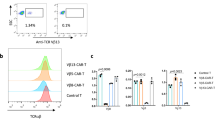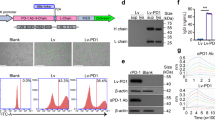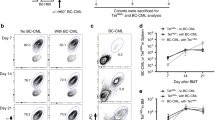Abstract
In order to treat common cancers with immunotherapy, chimeric receptors have been developed that combine the tumor specificity of antibodies with T-cell effector functions. Previously, we demonstrated that T cells transduced with a chimeric receptor gene against human ovarian cancer were able to recognize ovarian cancer cells in vitro and in vivo. We now report that recipients of bone marrow cells transduced with these genes exhibited significant antitumor activity in vivo. Moreover, in vivo depletion of T cells in reconstituted mice did not affect antitumor activity, suggesting that other immune cells expressing the chimeric receptor gene may play an important role in tumor rejection.
This is a preview of subscription content, access via your institution
Access options
Subscribe to this journal
Receive 12 print issues and online access
$209.00 per year
only $17.42 per issue
Buy this article
- Purchase on Springer Link
- Instant access to full article PDF
Prices may be subject to local taxes which are calculated during checkout
Similar content being viewed by others
References
Rosenberg, S.A. Immunotherapy and gene therapy of cancer. Cancer Res. (Suppl.) 51, 5074S–5079S (1991).
Rosenberg, S.A. Gene therapy for cancer. JAMA 268, 2416–2419 (1992).
Rosenberg, S.A. et al. Treatment of patients with metastatic melanoma with autol-ogous tumor-infiltrating lymphocytes and interleukin 2. J. Natl. Cancer Inst. 86, 1159–1161 (1994).
Eshhar, Z. & Gross, G. Chimeric T cell receptor which incorporates the anti-tumor specificity of a monoclonal antibody with the cytolytic activity of T cells: A model system for immunotherapeutical approach. Br.J. Cancer 62 (Suppl. 10), 27–29 (1990).
Gross, G. & Eshhar, Z. Endowing T cells with antibody specificity using chimeric T cell receptors. FASEB J. 6, 3370–3378 (1992).
Hwu, P. et al. Lysis of ovarian cancer cells by human lymphocytes redirected with a chimeric gene composed of an antibody variable region and the Fc receptor gamma chain. J. Exp. Med. 178, 361–366 (1993).
Eshhar, Z., Waks, T., Gross, G. & Schindler, D.G. Specific activation and targeting of cytotoxic lymphocytes through chimeric single chains consisting of antibody-binding domains and the γ or ξ subunits of the immunoglobulin and T-cell receptors. Proc. Natl. Acad. Sci. USA 90, 720–724 (1993).
Hwu, P. et al. In vivo antitumor activity of T cells redirected with chimeric anti-body/T-cell receptor genes. Cancer Res. 55, 3369–3373 (1995).
Royal, R.E., Daly, T., Rosenberg, S.A. & Hwu, P. Specific immune recognition of gastrointestinal cancer by lymphocytes expressing a chimeric T-cell receptor. Proc. Am. Assoc Cancer Res. 37, 481 (1996).
Roberts, M.R. et al. Targeting of human immunodeficiency virus-infected cells by CD8+ T lymphocytes armed with universal T-cell receptors. Blood 84, 2878–2889 (1994).
Walker, R.E. et al. A phase I/II pilot study of the safety of the adoptive transfer of syngeneic gene-modified cytotoxic T lymphocytes in HIV-infected identical twins. Hum. Gene Ther. 7, 367–400 (1996).
Tran, A.-C., Zhang, D., Bym, R. & Roberts, M.R. Chimeric ζ-receptors direct human natural killer (NK) effector function to permit killing of NK-resistant tumor cells and HIV-infected T lymphocytes. J. Immunol. 155, 1000–1009 (1995).
Moritz, D., Wels, W., Mattern, J. & Broner, B. Cytotoxic T lymphocytes with a grafted recognition specificity for ErbB2-expressing tumor cells. Proc. Natl. Acad. Sci. USA 91, 4318–4322 (1994).
Wels, W. et al. Biotechnological and gene therapeutic strategies in cancer treatment. Gene 159, 73–80 (1995).
Orloff, D.G., Ra, C.S., Frank, S.J., Klausner, R.D. & Kinet, J.R. Family of disulphide-linked dimers containing the zeta and eta chains of the T-cell receptor and the gamma chain of Fc receptor. Nature 347, 189–191 (1990).
Miotti, S. et al. Characterization of human ovarian carcinoma-associated antigens defined by novel monoclonal antibodies with tumor-restricted specificity. Int. J. Cancer 39, 297–303 (1987).
Coney, L.R. et al. Cloning of a tumor-associated antigen: MOv18 and MOvi 9 antibodies recognize a folate-binding protein. Cancer Res. 51, 6125–6132 (1991).
Shiloni, E. et al. Retroviral transduction of interferon-gamma cDNA into a nonim-munogenic murine fibrosarcoma: Generation of T cells in draining lymph nodes capable of treating established parental metastatic tumor. Cancer Immunol. Immunother. 37, 286–292 (1993).
Karp, S.E. et al. Cytokine secretion by genetically modified nonimmunogenic murine fibrosarcoma. Tumor inhibition by IL-2 but not tumor necrosis factor. J. Immunol. 150, 896–908 (1993).
Palmer, T.D., Rosman, G.J., Osborne, W.R.A. & Miller, A.D. Genetically modified skin fibroblasts persist long after transplantation but gradually inactivate introduced genes. Proc. Natl. Acad. Sci. USA 88, 1330–1334 (1991).
Brocker, T. & Karjalainen, K. Signals through T cell receptor γ chain alone are insufficient to prime resting T lymphocytes. J. Exp. Med. 181, 1653–1659 (1995).
Pardoll, D.M. et. al. Thymus-dependent and thymus-independent developmental pathways for peripheral T cell receptor-bearing lymphocytes. J. Immunol. 140, 4091–4096 (1988).
Miller, A.D. & Rosman, G.J. Improved retroviral vectors for gene transfer and expression. Biotechniques 7, 980-982, 984-986, 989–990 (1989).
Hoatlin, M.E., Kozak, S.L., Spiro, C. & Kabat, D. Amplified and tissue-directed expression of retroviral vectors using ping-pong techniques. J. Mol. Med. 73, 113–120 (1995).
Bodine, D.M., Karlsson, S. & Neinhuis, A.W. Combination of interleukins 3 and 6 preserves stem cell function in culture and enhances retrovirus-mediated gene transfer into hematopoietic stem cells. Proc. Natl. Acad. Sci. USA 86, 8897–8901 (1989).
Orlic, D. & Bodine, D.M. What defines a pluripotent hematopoietic stem cell (PHSC): Will the real PHSC please stand up! Blood 84, 3991–3994 (1994).
Jordan, C.T. & Lemischka, I.R. Clonal and systemic analysis of long-term hematopoiesis in the mouse. Genes Dev. 4, 220–232 (1990).
Sorrentino, B.P. et al. Selection of drug-resistant bone marrow cells in vivo after retroviral transfer of human MDR1. Science 257, 99–103 (1992).
Sykes, M. et al. Specific prolongation of skin graft survival following retroviral transduction of bone marrow with an allogeneic major histocompatibility complex gene. Transplantation 55, 197–202 (1993).
Kruisbeek, A.M. In vivo depletion of CD4- and CD8-specific T cells, in Current Protocols in Immunology, (eds. Coligan, J.E., Kruisbeek, A.M., Margulies, D.H., Shevach, EM. & Strober, W.) 4.1.1–4.1.5 (Wiley and Sons, New York, 1991).
Author information
Authors and Affiliations
Rights and permissions
About this article
Cite this article
Wang, G., Chopra, R., Royal, R. et al. A T cell-independent antitumor response in mice with bone marrow cells retrovirally transduced with an antibody/Fc-γ chain chimeric receptor gene recognizing a human ovarian cancer antigen. Nat Med 4, 168–172 (1998). https://doi.org/10.1038/nm0298-168
Received:
Accepted:
Issue Date:
DOI: https://doi.org/10.1038/nm0298-168
This article is cited by
-
Clinical application of genetically modified T cells in cancer therapy
Clinical & Translational Immunology (2014)
-
Immune escape from NY-ESO-1-specific T-cell therapy via loss of heterozygosity in the MHC
Gene Therapy (2014)
-
Retargeting NK92 cells using an HLA-A2-restricted, EBNA3C-specific chimeric antigen receptor
Cancer Gene Therapy (2012)
-
Antibody-targeted cell fusion
Nature Biotechnology (2004)
-
Targeting tumours with genetically enhanced T lymphocytes
Nature Reviews Cancer (2003)



